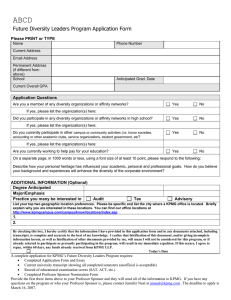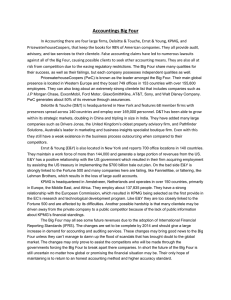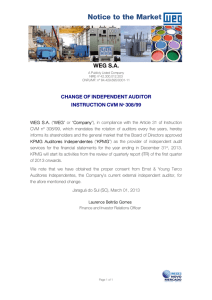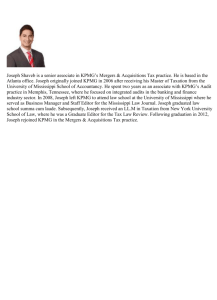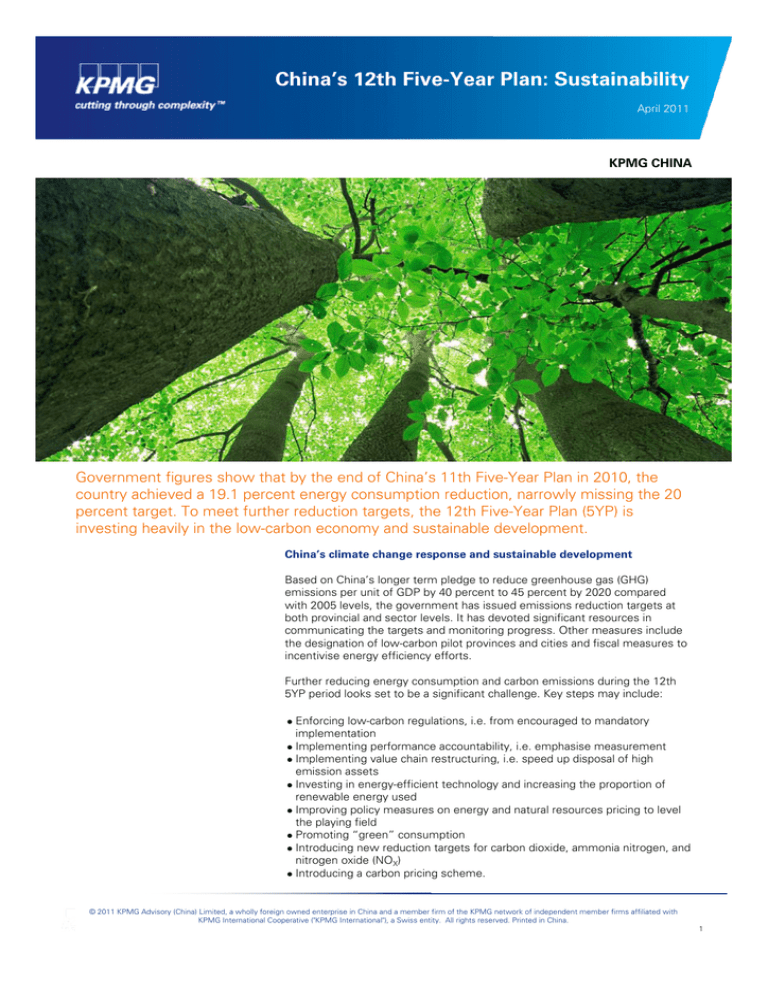
China’s 12th Five-Year Plan: Sustainability
April 2011
KPMG CHINA
Government figures show that by the end of China’s 11th Five-Year Plan in 2010, the
country achieved a 19.1 percent energy consumption reduction, narrowly missing the 20
percent target. To meet further reduction targets, the 12th Five-Year Plan (5YP) is
investing heavily in the low-carbon economy and sustainable development.
China’s climate change response and sustainable development
Based on China’s longer term pledge to reduce greenhouse gas (GHG)
emissions per unit of GDP by 40 percent to 45 percent by 2020 compared
with 2005 levels, the government has issued emissions reduction targets at
both provincial and sector levels. It has devoted significant resources in
communicating the targets and monitoring progress. Other measures include
the designation of low-carbon pilot provinces and cities and fiscal measures to
incentivise energy efficiency efforts.
Further reducing energy consumption and carbon emissions during the 12th
5YP period looks set to be a significant challenge. Key steps may include:
Enforcing low-carbon regulations, i.e. from encouraged to mandatory
implementation
Implementing performance accountability, i.e. emphasise measurement
Implementing value chain restructuring, i.e. speed up disposal of high
emission assets
Investing in energy-efficient technology and increasing the proportion of
renewable energy used
Improving policy measures on energy and natural resources pricing to level
the playing field
Promoting “green” consumption
Introducing new reduction targets for carbon dioxide, ammonia nitrogen, and
nitrogen oxide (NOX)
Introducing a carbon pricing scheme.
© 2011 KPMG Advisory (China) Limited, a wholly foreign owned enterprise in China and a member firm of the KPMG network of independent member firms affiliated with
KPMG International Cooperative ("KPMG International"), a Swiss entity. All rights reserved. Printed in China.
1
Key binding targets in the 12th Five-Year Plan
Binding
target at
the end of
2015 (%)
Indicator
Water usage reduction per unit of
industrial added value
-30
Non-fossil fuel consumption vs.
total primary energy consumption
+3.1
Energy reduction per unit of GDP
-16
CO2 emissions reduction per unit
of GDP
-17
Emissions
reduction of key
pollutants
COD
-8
SO2
-8
Ammonia
nitrogen
-10
NOX
-10
Forest coverage
What businesses are doing in China
Businesses are increasingly concerned about climate change and sustainability
as a result of pressure from regulations and stakeholders.
In the wake of a series of highly-publicized global climate conferences and
China’s public commitment to emissions reduction targets, businesses are
being forced to shift their attention inwards.
+1.3
China aims to cut the amount of energy and carbon dioxide emissions
needed for every unit of economic output by 16 percent and 17 percent,
respectively, over the five years to 2015. This is consistent with China’s
long-term plan to cut carbon intensity by 40 percent to 45 percent by 2020,
relative to 2005 levels.
Companies are paying more attention. Most industry leaders already have
or are developing a sustainability/CSR strategy that is in line with their
overall business strategy.
Companies and their stakeholders are recognising challenges and
opportunities brought by climate change.
Some sectors (such as iron and steel, airlines, and cement) have both high
emissions intensity and a high cost to reduce emissions.
An increasing number of companies are building carbon inventory
specifically in preparation for carbon reporting.
Although sustainability and climate change have been gradually moving
onto the board agenda, they remain for the most part at the project level
with a technology focus.
Impacts of climate policy on business sectors
Source:
The CEO guide to carbon report, KPMG Australia
In 2009, Chinese companies and subsidiaries of multinational companies in
China disclosed 663 sustainability reports, up from only 77 in 2006.
Number of sustainability disclosures
663
582
77
2006
Sources:
121
2007
2008
2009
(1) Research on CSR reporting in China 2009, Syntao ;
(2) Research on Corporate Social Responsibility Reporting in China 2010, WTO Tribune
© 2011 KPMG Advisory (China) Limited, a wholly foreign owned enterprise in China and a member firm of the KPMG network of independent member firms affiliated with
KPMG International Cooperative ("KPMG International"), a Swiss entity. All rights reserved. Printed in China.
2
Implications and insights
The transition to a low carbon economy marks the most significant change to
business in decades:
More businesses are starting to put in place a carbon strategy and
establish a carbon reporting system
Businesses are increasingly expected to disclose their carbon and
sustainability information
More companies are likely to establish a management structure to monitor
the achievement of low-carbon and sustainable development objectives,
including internal audit and/or external independent assurance
As carbon pricing is being considered, businesses will need to design a
marginal carbon abatement cost curve based on current emissions sources,
emissions intensity, carbon pricing forecasts, availability and cost of
abatement options
Further consolidation in the carbon-intensive sectors, for example natural
resources, iron and steel, as smaller and older plants are being shut down
Sustainability is increasingly seen as a must-have strategic tool to create
company value to meet both internal and external stakeholder demands.
Responses from selected industry participants
Company
Baosteel
Sector
Iron & Steel
Current status of carbon management
China
Construction
Bank
Banking
China Shenhua
Energy
Power
Sinopec
Oil & Gas
State Grid
Utility
Has a sustainability strategy and management system in
place; plans to develop a strategy for low-carbon
development and CO2 emissions data collection
Conducting research and development on low-carbon
technologies, CO2 recycling, utilization, absorption and
solidification; promoting the use of advanced technologies
for energy conservation and emissions reduction
Participating in Clean Development Mechanism (CDM) and
the Asia-Pacific Clean Development and Climate
Partnership (APP)
Promoting “Green Financing”
Strengthening the green credit approval process based on
potential borrowers’ environmental and energy track
records
Preparing for the implementation of the Equator Principles
Implementing measures to reduce its own carbon footprint
Has a CSR strategy and management system
Has an energy and emissions data collection, measurement
and monitoring system
Conducting R&D on low carbon and clean coal technology
Participating in CDM
Improving energy efficiency by eliminating outdated
production capacity and upgrading technology at key
facilities
Switching refinery gas flaring to recycling
Strengthening R&D on low carbon technology, including
CO2 capture and use, and new energy
Participating in CDM
Has a sustainability strategy and management system in
place
Established a Smart Grid development strategy
Publically disclosed its CO2 emissions data
R & D in renewable energy technologies
Increasing power generation capacity from renewable
energy sources
© 2011 KPMG Advisory (China) Limited, a wholly foreign owned enterprise in China and a member firm of the KPMG network of independent member firms affiliated with
KPMG International Cooperative ("KPMG International"), a Swiss entity. All rights reserved. Printed in China.
3
Sector Leader
Leah Jin
Partner
leah.jin@kpmg.com
Potential “green” opportunities
Create competitive advantage by strategically implementing energy
efficiency and/or clean energy measures ahead of carbon pricing
Energy Performance Contracting related energy efficiency services, products,
and financing
Create product differentiation by training and working with suppliers and
creating a sustainable supply chain
Energy efficiency, new energy, and clean energy cars are three key
investment areas (among seven special sectors) identified in China’s 12th
5YP
Financial investors have investment opportunities given the significant capital
expenditure (CAPEX) needed for clean energy
Low carbon pilot city initiatives create multiple opportunities in city planning,
CDM project portfolios, and technology innovation.
Potential risks and barriers
Loss of license to operate for energy inefficient assets/plants
Unfavourable cost structure due to imminent carbon pricing
Fraud in green financing portfolios
Unrecognised carbon/environmental liability in targets or newly acquired
assets
Unclear monitoring, reporting and verification (MRV) mechanism for carbon
emissions
Unsophisticated local suppliers lack sustainability knowledge, framework,
models, and systems
CEO checklist
Is your business involved in "high risk" sectors with significant greenhouse
gas emissions, particularly mining, energy, manufacturing and
transportation?
Does your supply chain include greenhouse gas intensive goods and
services?
Is your business sensitive to a tax or a cap on greenhouse gas emissions?
Are you considering acquisitions, mergers or JV partnerships that may
require you to consider the impact of carbon emissions?
Do you feel confident about explaining your organisation’s climate policy
and reporting at a shareholders' meeting?
Do you plan on upgrading to cleaner technology?
DISCLAIMER: The information herein has been obtained from public sources believed to be reliable. The views and opinions in this memo are those
of the authors. KPMG makes no representation as to the accuracy or completeness of such information.
© 2011 KPMG Advisory (China) Limited, a wholly foreign owned enterprise in China and a member firm of the KPMG network of independent member firms affiliated with
KPMG International Cooperative ("KPMG International"), a Swiss entity. All rights reserved. Printed in China.
4

